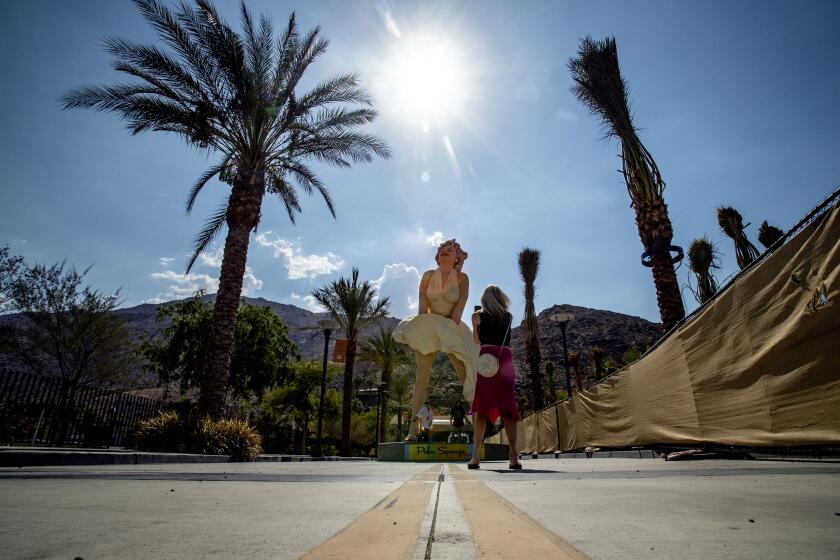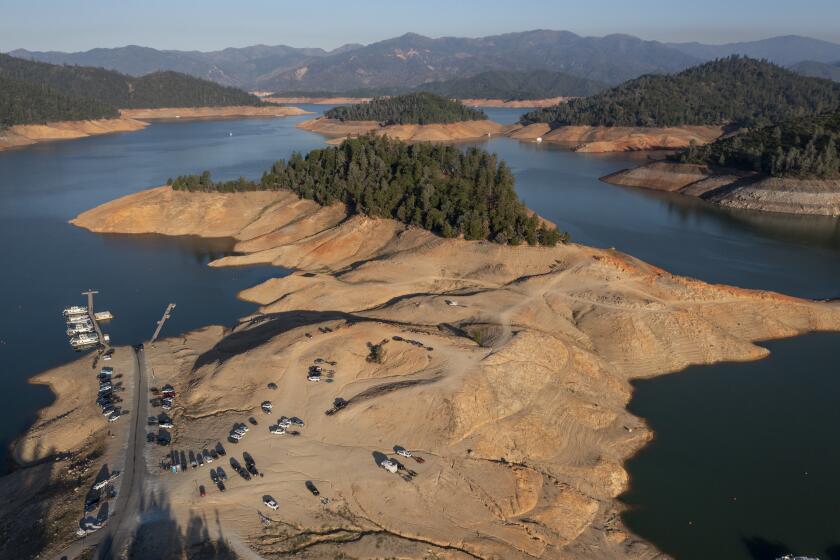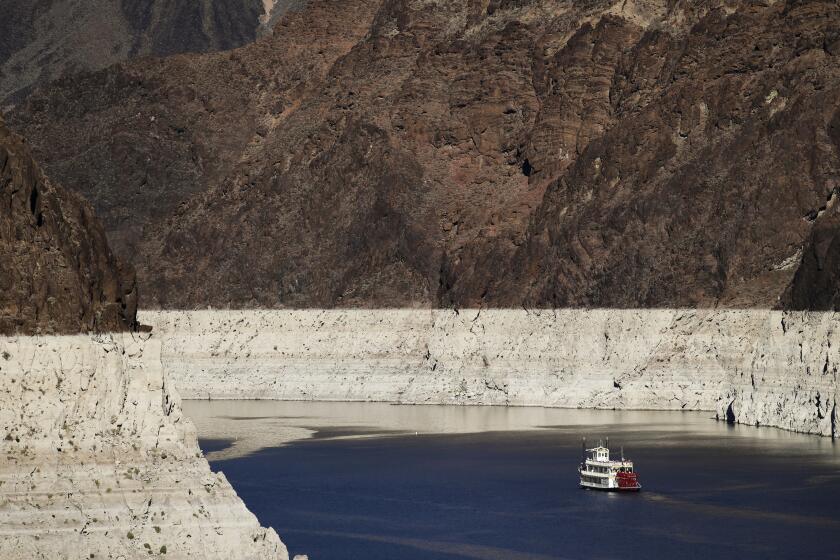How bad is this year’s fire season? Even the firefighters are worried

- Share via
At Oak Flat Fire Station in the Angeles National Forest, veteran firefighters are already getting a bad feeling about this year.
There has been so little rain, and rising temperatures caused by climate change have made the landscape drier than they’ve ever seen — ready to combust with the smallest spark.
They’ve watched the rugged mountains of the forest around the Castaic station change before their eyes, from a place of seasons to a place that seems like it is in perpetual summer. And with homes encroaching farther into the terrain each year, there are more people in harm’s way.
The firefighters’ readiness and anxiety now hang in the air, as thick as the dead, dry brush clinging to the surrounding hillsides.
Record temperatures are expected for the region. They could be deadly, and they are a clear impact of climate change, scientists say.
“My first winter here, I was burning piles in thigh-deep snow,” said Christian Bauzo, a firefighter who has been with the Forest Service for 15 years. “Now it’s like, ‘What winter?’ Almost all winter we were fighting fire.”
Bauzo and his crew now respond to at least two wildfires a week. And because it keeps getting hotter, and the landscape has shifted and the dangers have increased, they are having to change how they approach the flames.
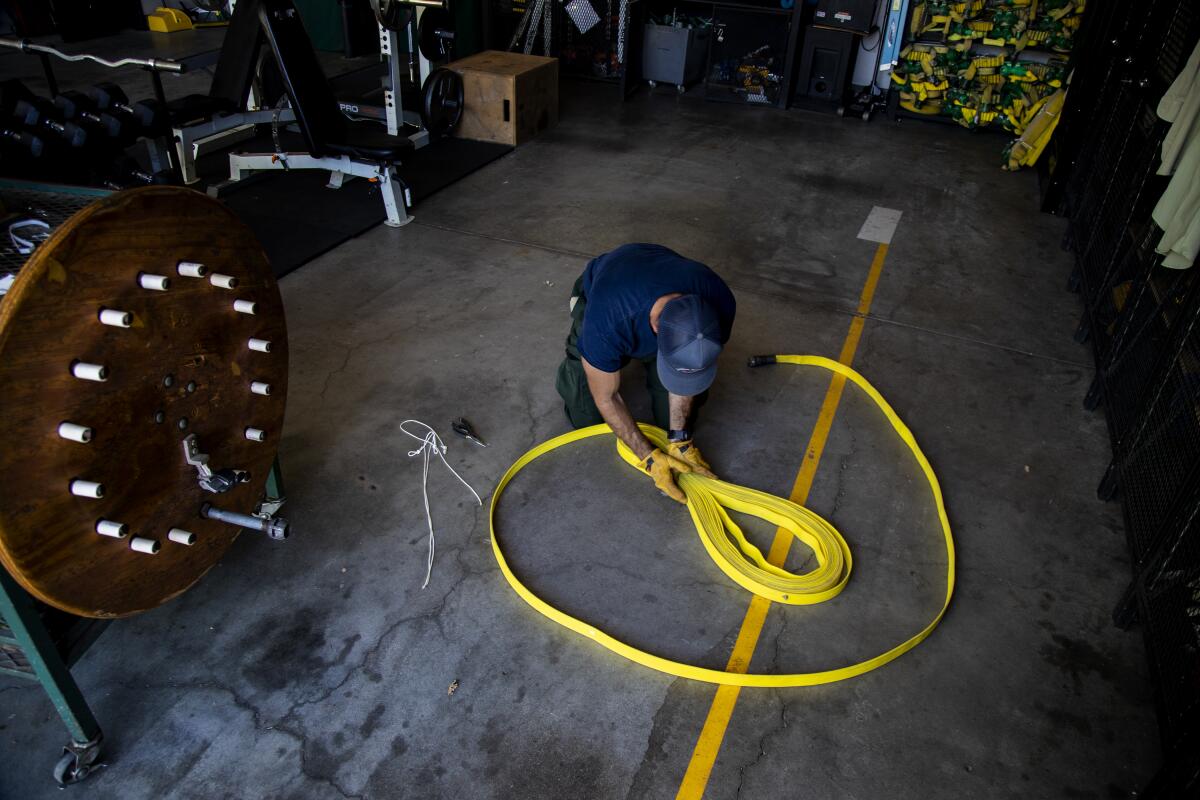
Until the 1970s, firefighters in the Angeles National Forest used to follow something called the “10 a.m. rule,” which meant that crews had to put out every wildfire by 10 the morning after a blaze ignited, said Diane Travis, a fuels manager who has been with the Forest Service for more than 30 years.
The notion seems laughable in today’s climate, where many fires grow too fast and too large for that to be a reasonable expectation. Now, crews have no seconds to spare, and have to hit the fires hard before they get out of control.
Back then, Travis said, it was a “different type of ecosystem.”
A century of fire suppression has created a buildup of fuel, while decades of population growth and development have formed new obstacles. And from the ongoing drought to more frequent heat waves, the approach to wildfire management and strategy has had to evolve with the times.
A worsening drought is further drying out parched vegetation, which could be fuel for a disastrous fire season.
The Angeles National Forest is home to about 700,000 acres of oaky woodlands and dense shrubbery that skirt the north and eastern edges of Los Angeles County. The U.S. Forest Service calls it one of the “driest, most fire-prone areas in the United States,” where human-caused fires are becoming larger and more frequent.
Last year, the Bobcat fire burned more than 115,000 acres of the forest and came within feet of the historic Mt. Wilson Observatory, casting a sickly pall of black smoke and orange skies over northeast L.A. for days.
At the Oak Flat Station, hotshot squad boss Justine Gude said she worked 1,600 hours of overtime last year, by far the most in her nine years with the Forest Service. This year is shaping up to be similarly grueling.
“This particular year is the driest I’ve ever seen it,” Gude said, noting that the recent North fire in Castaic was “really scary to see in April” because it burned more like a fire in August: hot and fast.
And while her team would normally encounter wildflowers and grasses during their routine trail maintenance, the paths today look as shriveled as they did last fall.
“There’s been no new growth,” Gude said. “We’ve been in critical [mode] for two or three months already on this side of the forest.”
Angeles National Forest Fire Chief Robert Garcia said vegetation dryness in the region is well ahead of where it should be.
“We are extremely concerned based on our local conditions and conditions throughout the state,” Garcia said by phone. “The conditions we’re experiencing now are typical of the seasonal averages that we see in August and into September in most years.”
An alarmingly low rainfall year has contributed to that dryness, with the state’s fire officials warning that a single spark or strike of lightning is enough to ignite a potentially catastrophic blaze.
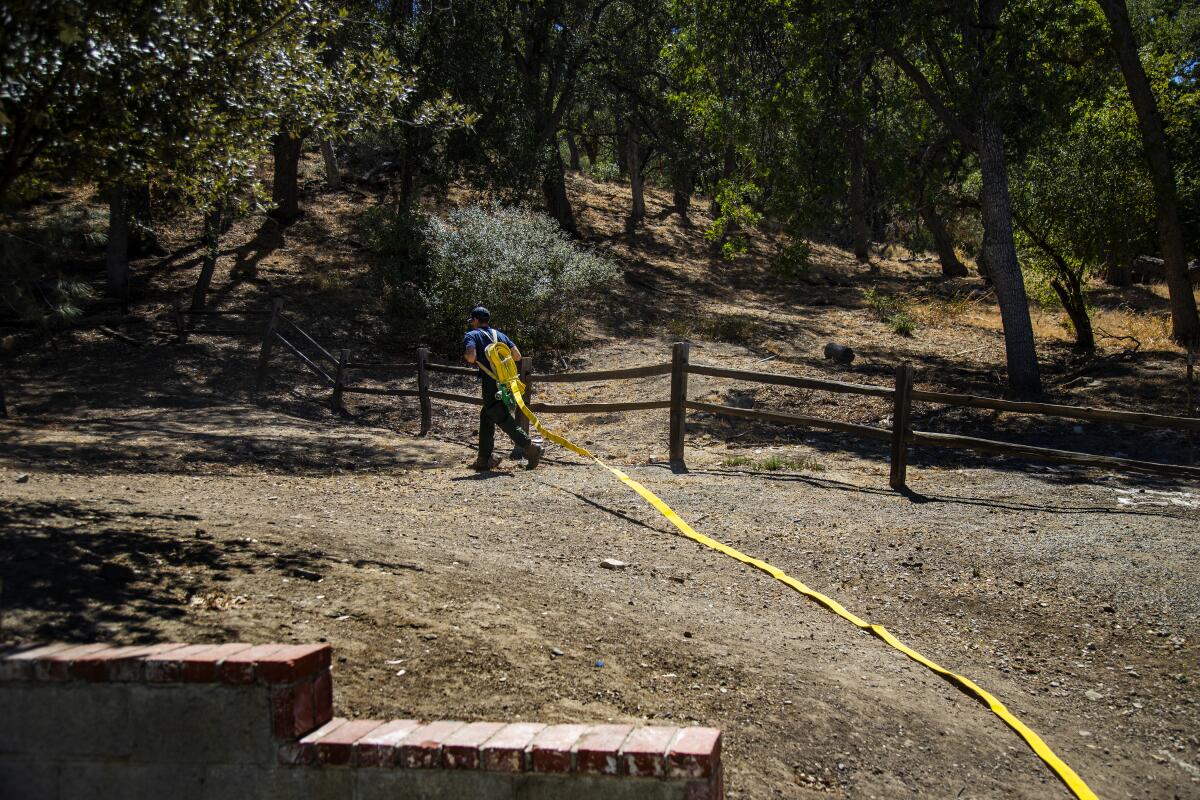
But it’s not just the dryness that is concerning, according to Deputy Fire Chief Shane Olpin, who has been with the Forest Service for 26 years. On a recent Saturday, Olpin kept a watchful eye on the crew as he sought shelter from the brutal midday sun.
Over the course of his career in various Western states, the biggest change isn’t heat and drought, Olpin said — it’s urban sprawl.
“If you’re talking about some of the complexities down here in Southern California, it would be more the sprawl of development, and us moving into an ecosystem,” he said. “The landscape has always burned, but now we have homes and infrastructure on the landscape that we have to be concerned about.”
The population of California has quadrupled since the 1950s, according to state data, and with that explosion have come more homes, more construction and far more opportunities for wildfires to ignite.
And while firefighters in more rural states such as Idaho and Montana sometimes have the option of allowing remote wildfires to burn, Olpin said, that’s not so easy in Southern California, where quick-to-ignite fires are rarely far from freeways, power lines or people.
“Allowing fire to play a natural role on the landscape would be nice, but I just don’t think it’s feasible here,” he said.
Travis, the fuels planner, said the Angeles National Forest does use prescribed, or planned, burns in the spring and fall to help manage forest health. Prescribed burns can reduce the buildup of dead vegetation on the forest floor and replenish nutrients in the soil.
But the requisite environmental review process for those burns can take up to a year, and the state’s climate is becoming increasingly unpredictable. The Angeles National Forest is 60% chaparral, she said, and its growth cycle is falling way out of whack with drier falls and less new growth in the spring.
There are other regional factors that add to the area’s challenges, Olpin said, including wildlife habitats, gusty Santa Ana winds and even L.A.’s notorious traffic and media market. But no pressure is greater than what he feels for his crew.
“We know that we’re going to lose young kids [to these fires], and we already have,” he said. “That’s what weighs on management: just making sure they’re properly trained and prepared and fit, and ready to do the job that we ask them to do.”
There’s a drought in the West. Here’s what you need to know about climate change, heat waves, wildfires, and more.
And the job is grueling.
Because of the steep forest terrain, trucks can’t always drive up to the line of fire. That means firefighters are parking and hiking uphill — often with two or three 28-pound hose packs on their backs — in temperatures that now regularly soar into triple digits.
Heat-related illnesses and injuries are not uncommon, said Nick Browne, 25, who is entering his fourth season of fighting fires with the Forest Service.
Browne demonstrated how the crew’s perfectly packed hose lines are designed to unravel as they walk uphill, like a strategic ball of yarn, and emphasized how important it is to hit flames with a precise stream or spray of water. The wrong angle could send embers flying and ignite a new blaze.
“The operational tempo in [this region] is very aggressive,” Browne said, noting that crews in the bone-dry forest must aim for 100% mop-up, meaning they must extinguish every ember. “There are no shortcuts here.”
But fire behavior also has changed in recent decades, the crew said. Wildfires are arriving earlier and more frequently than in the past, and the number of acres burned is increasing.
There are several reasons for this shift in ecology, including the fact that firefighters have been squelching the forest’s fires for more than a century in order to protect the surrounding communities. The action helps people but allows flammable, dead vegetation to pile up on the forest floor.
“We’ve had 100 years of suppression,” Travis said, “so we’ve created an ecosystem that burns differently.”
Even prescribed burns, which take into account factors like botany, wildlife, hydrology and archaeology, are becoming risky in the region. Travis said most planned burns that do get approved can’t be very large.
“It’s not that the risk of escape is very high,” she said of controlled fires, “it’s that there are very high consequences if they do.”
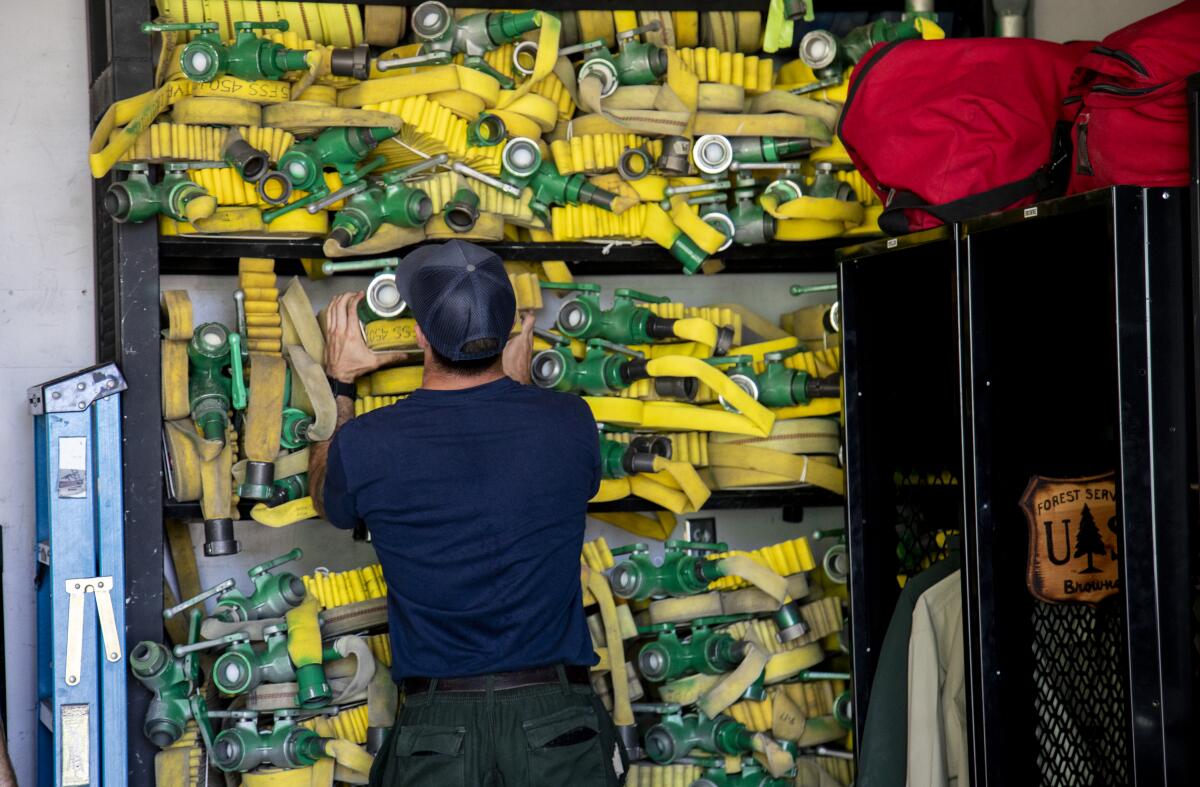
But perhaps one of the greatest challenges heading into the 2021 fire season is the psychological toll.
Firefighters are finding it necessary to increase the pace and scale of their work even though there aren’t always accompanying increases in resources. During the worst months of fire season, they are regularly assigned to 24-hour shifts.
Browne has been on the job since he was 19 and has experienced moments both terrifying and humbling in the face of scorching flames, he said. He even left the Forest Service briefly to explore other career options but came back because he missed the culture and the calling.
Last year, Gude deployed to Australia to help fight that country’s catastrophic wildfires, which burned more than 30 million acres. And while those fires were dangerous and challenging, she said, “the complexity level here is up 1,000%” from any other place she has worked.
“Southern California is the hardest place to fight fire,” she said. “It’s not for the faint of heart.”
Bauzo, who is about to have his fifth child with his fiancée, said he worries about staying in touch with his family while battling blazes in remote areas with limited cell reception.
He also recalled his rookie season 15 years ago, when the hillsides lining the nearby 5 Freeway were lush and green on his drive into work.
But amid worsening heat and drought conditions, those hillsides are now brown, and the fire season hardly seems to end.
“It seems,” he said, “like we’re going to have a whole year of summer.”
More to Read
Sign up for Essential California
The most important California stories and recommendations in your inbox every morning.
You may occasionally receive promotional content from the Los Angeles Times.
